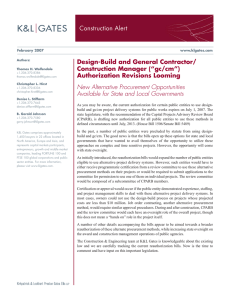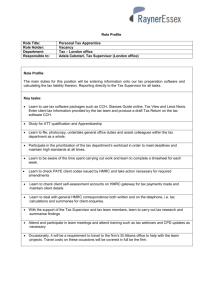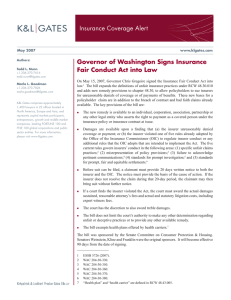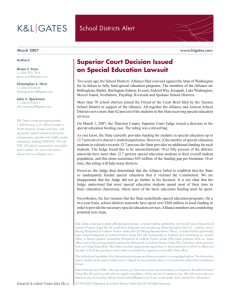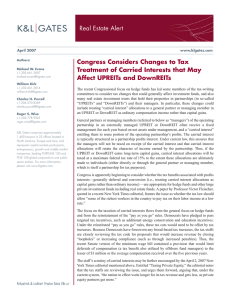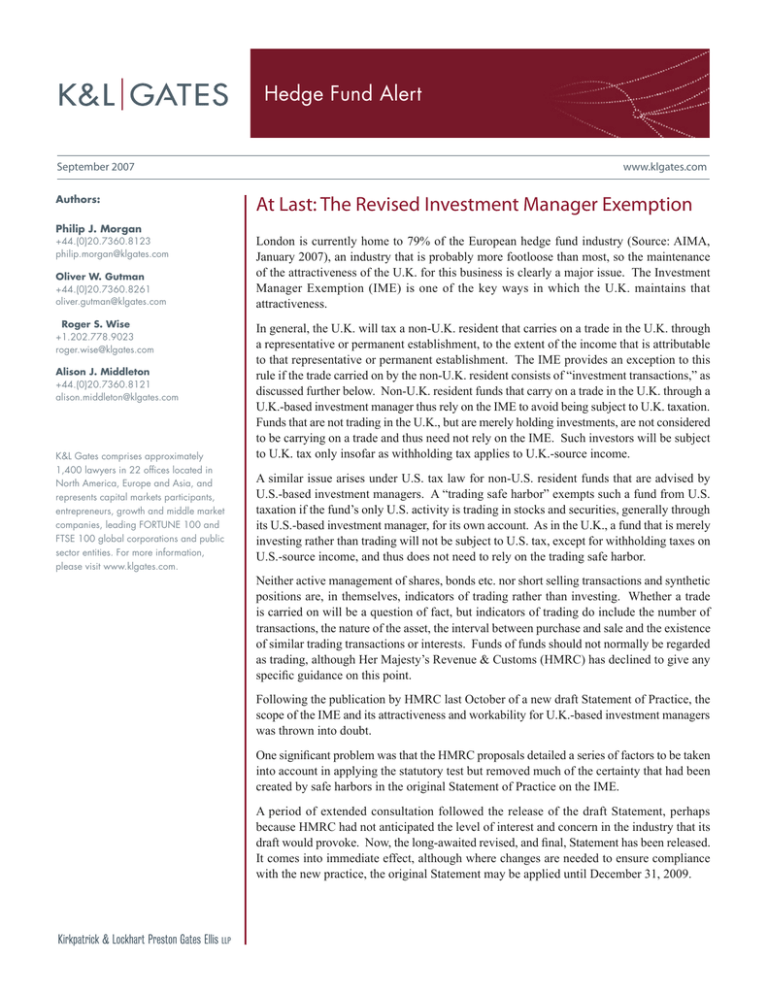
Hedge Fund Alert
September 2007
Authors:
Philip J. Morgan
+44.(0)20.7360.8123
philip.morgan@klgates.com
Oliver W. Gutman
+44.(0)20.7360.8261
oliver.gutman@klgates.com
Roger S. Wise +1.202.778.9023
roger.wise@klgates.com
Alison J. Middleton
+44.(0)20.7360.8121
alison.middleton@klgates.com
K&L Gates comprises approximately
1,400 lawyers in 22 offices located in
North America, Europe and Asia, and
represents capital markets participants,
entrepreneurs, growth and middle market
companies, leading FORTUNE 100 and
FTSE 100 global corporations and public
sector entities. For more information,
please visit www.klgates.com.
www.klgates.com
At Last: The Revised Investment Manager Exemption
London is currently home to 79% of the European hedge fund industry (Source: AIMA,
January 2007), an industry that is probably more footloose than most, so the maintenance
of the attractiveness of the U.K. for this business is clearly a major issue. The Investment
Manager Exemption (IME) is one of the key ways in which the U.K. maintains that
attractiveness.
In general, the U.K. will tax a non-U.K. resident that carries on a trade in the U.K. through
a representative or permanent establishment, to the extent of the income that is attributable
to that representative or permanent establishment. The IME provides an exception to this
rule if the trade carried on by the non-U.K. resident consists of “investment transactions,” as
discussed further below. Non-U.K. resident funds that carry on a trade in the U.K. through a
U.K.-based investment manager thus rely on the IME to avoid being subject to U.K. taxation.
Funds that are not trading in the U.K., but are merely holding investments, are not considered
to be carrying on a trade and thus need not rely on the IME. Such investors will be subject
to U.K. tax only insofar as withholding tax applies to U.K.-source income.
A similar issue arises under U.S. tax law for non-U.S. resident funds that are advised by
U.S.-based investment managers. A “trading safe harbor” exempts such a fund from U.S.
taxation if the fund’s only U.S. activity is trading in stocks and securities, generally through
its U.S.-based investment manager, for its own account. As in the U.K., a fund that is merely
investing rather than trading will not be subject to U.S. tax, except for withholding taxes on
U.S.-source income, and thus does not need to rely on the trading safe harbor.
Neither active management of shares, bonds etc. nor short selling transactions and synthetic
positions are, in themselves, indicators of trading rather than investing. Whether a trade
is carried on will be a question of fact, but indicators of trading do include the number of
transactions, the nature of the asset, the interval between purchase and sale and the existence
of similar trading transactions or interests. Funds of funds should not normally be regarded
as trading, although Her Majesty’s Revenue & Customs (HMRC) has declined to give any
specific guidance on this point.
Following the publication by HMRC last October of a new draft Statement of Practice, the
scope of the IME and its attractiveness and workability for U.K.-based investment managers
was thrown into doubt.
One significant problem was that the HMRC proposals detailed a series of factors to be taken
into account in applying the statutory test but removed much of the certainty that had been
created by safe harbors in the original Statement of Practice on the IME.
A period of extended consultation followed the release of the draft Statement, perhaps
because HMRC had not anticipated the level of interest and concern in the industry that its
draft would provoke. Now, the long-awaited revised, and final, Statement has been released.
It comes into immediate effect, although where changes are needed to ensure compliance
with the new practice, the original Statement may be applied until December 31, 2009.
Hedge Fund Alert
On the major points of concern with the draft Statement
published last year, HMRC has moved significantly to
allay industry fears such as those expressed on behalf
of hedge fund managers by the Alternative Investment
Management Association (AIMA), of which we are a
member. As a result, overall the new Statement should
be welcomed; it includes much of the certainty of the
original Statement and in some cases extends the scope
of the IME. The main points to note are as follows:
Permitted Transactions
The IME applies only to investment transactions.
The new Statement extends the range of assets and
activities that now count as investment transactions.
Now included are credit default swaps (whether settled
physically or by cash), contracts for difference and
carbon emission credits. The Statement also clarifies
that futures and options relating to commodities that
provide for physical delivery are covered, as long as
physical delivery of the commodities does not occur
(this is because transactions in commodities are not
considered to be investment transactions).
This extra flexibility and clarity is helpful, although
HMRC did not accept all AIMA suggestions in this
area - for example, it has excluded taking a lead in
arranging a syndicate to advance a loan from the
definition of investment transactions.
The “Cliff-Edge” Problem
It was previously widely believed that, where an
investment manager undertook any activity that fell
outside the definition of investment transactions, the
conditions for the IME would not be met: i.e., a single
departure from the investment transaction definition
could prejudice the exempt status of the whole fund.
Importantly, the new Statement confirms that a minor
or inadvertent transaction that is not covered by
the definition of an investment transaction will not
prejudice the availability of the IME, provided that
any profit from the transaction is charged to U.K.
tax. To determine whether a transaction is minor or
inadvertent, HMRC will look at the size and nature of
the transaction, the intention of the parties, the reasons
why the transaction took place and whether there has
been a recurrence.
While this confirmation is helpful, it has opened up
an area ripe for debate and it will be interesting to see
how the phrase “minor or inadvertent” is interpreted
in practice.
The Independence Test
The IME applies only if the investment manager acts
for the non-U.K. resident fund in an independent
capacity. This means, according to the revised
Statement, looking at whether, having regard to its
legal, financial and commercial characteristics, the
relationship between the fund manager and the fund is
between persons carrying on business on arm’s-length
terms.
The original Statement helpfully contained five
safe harbor tests and the independence test could be
regarded as satisfied if any one of those tests was met.
The draft Statement issued last year removed those
tests and instead HMRC stated that it would look at
the overall position, in accordance, broadly, with the
guidelines applying to double tax treaties. This move
was widely criticized and HMRC has largely reverted
to the previous approach by applying a hierarchy of
tests in the new Statement.
The hierarchy now applies as follows. The relationship
will be considered to be independent if the non-resident
is a widely held collective fund or is actively marketed
with the intention that it becomes one or is being
wound up or dissolved. A fund will be widely held
if no majority interest is held by 5 or fewer persons
(and persons connected with them) or if no interest of
more than 20% is held by a single person and persons
connected with that person. There is an 18 month grace
period for new funds to meet the widely held test.
The extension of this test to funds being actively
marketed was not in the original Statement. The 18
month grace period in this context is also new, and
recognizes the need to build a track record before
new investors can be attracted. Because connected
persons are treated as a single investor for this purpose,
investments by related persons or entities might cause a
fund to fail the independence test. Such a fund would
need to rely on one of the other safe harbors described
below.
September 2007 | Hedge Fund Alert
In other cases, the provision of services to the
non-resident must not be a substantial part of the
investment manager’s business (substantial for this
purpose meaning 70% by reference to fees or some
other measure if that would be appropriate - and
again there is an 18 month grace period for a new
business with provisions to mitigate the position if
the 70% threshold is still exceeded after 18 months).
The possible mitigation is new but otherwise this is
essentially unchanged from the previous Statement.
As previously, if the 20% threshold is exceeded, the
IME does not apply to the part of the fund’s income
to which the U.K. investment manager and connected
persons are entitled. The rest of the fund’s income
remains subject to the IME if otherwise eligible. Just
as when applying the independence test, it is important
to give careful consideration in applying the 20% rule
to the definition of connected persons.
If the substantial test is not satisfied, HMRC will then
look at the overall relationship between the investment
manager and the non-resident fund to determine
whether they are carrying on independent business
on arm’s-length terms (this was also the case with the
original Statement).
The investment manager must receive remuneration
at a rate that is not less than customary. HMRC has
confirmed that it will consider this test to have been
satisfied if the arm’s-length test has been met for
transfer pricing purposes, and will look at the overall
remuneration arrangements. Investment managers will,
therefore, need to review their transfer pricing policies
to ensure that net remuneration in the U.K. is not out of
line with appropriate comparables. HMRC will look at
the net effect of the arrangements to determine whether
the test is met. However, even if there is a dispute, it
may be possible to agree with HMRC to adjust the
fee received by the investment manager in certain
circumstances, without prejudicing the IME.
HMRC has also usefully clarified that in master/
feeder structures the independence test will be applied
by looking through the master fund to beneficial
ownership of the feeder fund. A similar principle
applies to umbrella funds.
Probably the most significant change in relation to the
independence test is the removal of the safe harbor
that applied where the fund is quoted on a recognized
stock exchange. However, many offshore funds are
not listed and those that are will likely satisfy other
independence criteria.
The 20% Rule
The investment manager and persons connected with it
must not be beneficially entitled to more than 20% of
the non-resident fund’s chargeable profit arising from
transactions carried out through the U.K. investment
manager. As in the original Statement, fees paid to the
investment manager - including performance fees - are
not included in the non-resident’s chargeable profit as
long as they would be deductible in calculating the
non-resident’s profit if it were subject to U.K. tax.
HMRC has clarified its position on deferred fees and
shares and other interests in the fund awarded to the
manager. If the manager’s beneficial entitlement to fund
profits is increased by the return on those entitlements,
that increase has to be taken into account in calculating
whether the 20% rule has been breached. There is also
clarification that options on shares in the fund need
only be taken into account for these purposes when the
options are exercised.
The Customary Remuneration Test
HMRC has rejected the AIMA contention that only
gross fees should be taken into account for these
purposes but this may not matter as the Statement also
recognizes that there are a variety of ways in which the
remuneration can be paid to the investment manager
- such as rebated or reduced fees - without prejudicing
the arm’s-length test and the IME.
Conclusion
Overall, this is far better than was expected immediately
following the publication of the draft Statement last
year. On the whole, few arrangements should be
adversely affected, even those where a U.K.-based
manager manages only one fund, so the feared exodus
of U.K.-based investment managers appears to have
been avoided.
September 2007 | Hedge Fund Alert
K&L Gates comprises multiple affiliated partnerships: a limited liability partnership with the full name Kirkpatrick & Lockhart Preston Gates Ellis
LLP qualified in Delaware and maintaining offices throughout the U.S., in Berlin, and in Beijing (Kirkpatrick & Lockhart Preston Gates Ellis LLP
Beijing Representative Office); a limited liability partnership (also named Kirkpatrick & Lockhart Preston Gates Ellis LLP) incorporated in England
and maintaining our London office; a Taiwan general partnership (Kirkpatrick & Lockhart Preston Gates Ellis) which practices from our Taipei
office; and a Hong Kong general partnership (Kirkpatrick & Lockhart Preston Gates Ellis, Solicitors) which practices from our Hong Kong office.
K&L Gates maintains appropriate registrations in the jurisdictions in which its offices are located. A list of the partners in each entity is available
for inspection at any K&L Gates office.
This publication/newsletter is for informational purposes and does not contain or convey legal advice. The information herein should not be used
or relied upon in regard to any particular facts or circumstances without first consulting a lawyer.
Data Protection Act 1998—We may contact you from time to time with information on Kirkpatrick & Lockhart Preston Gates Ellis LLP seminars
and with our regular newsletters, which may be of interest to you. We will not provide your details to any third parties. Please e-mail london@
klgates.com if you would prefer not to receive this information.
©1996-2007 Kirkpatrick & Lockhart Preston Gates Ellis LLP. All Rights Reserved.
September 2007 |

